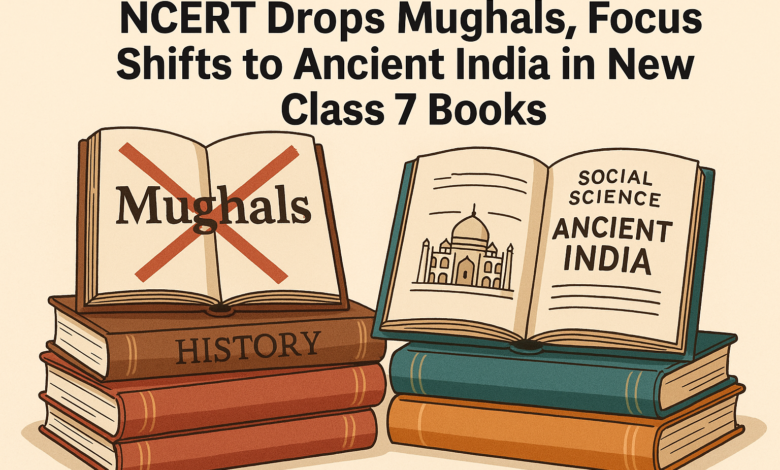NCERT Overhauls Class 7 Curriculum: Mughal, Sultanate Erased, Focus Shifts to Ancient India and National Programs

New Delhi I Apr I 27 :
NCERT Overhauls Class 7 Curriculum: Mughal, Sultanate Erased, Focus Shifts to Ancient India and National Programs
In a major revamp of the Class 7 Social Science curriculum, the National Council of Educational Research and Training (NCERT) has removed all references to the Mughals and Delhi Sultanate, replacing them with new chapters centered around ancient Indian dynasties, sacred geography, and contemporary government initiatives. The updated textbooks, launched this week, are aligned with the objectives of the National Education Policy (NEP) and the 2023 National Curriculum Framework for School Education (NCFSE), which stress the inclusion of indigenous traditions, knowledge systems, and local heritage in education.
According to NCERT officials, the revised content forms the first part of the new textbook, while the second part is anticipated in the coming months, news agency PTI reported. Officials, however, did not clarify if content related to the Mughals or Delhi Sultanate would reappear in subsequent editions. This update follows earlier textbook changes during 2022-23, when detailed sections on dynasties like the Tughlaqs, Khaljis, Mamluks, and Lodis were reduced, along with a table summarizing Mughal rulers’ achievements. The current revision has completely excluded those historical references.
New Textbook Content Highlights Ancient Dynasties, Sacred Geography, and National Initiatives
The newly titled Social Science textbook, Exploring Society: India and Beyond, now introduces students to prominent ancient dynasties such as the Magadha, Mauryas, Shungas, and Sātavāhanas. A major addition is the chapter “How the Land Becomes Sacred,” which explores the religious and cultural significance of sacred sites across India and other world religions, covering pilgrimage networks like the 12 jyotirlingas, Char Dham, and Shakti Pithas, as well as important natural sites like river confluences and mountains.
A quote from Jawaharlal Nehru describes India as “a land of pilgrimages—from the icy peaks of Badrinath and Amarnath to the southern tip at Kanyakumari,” reflecting the textbook’s thematic focus on spirituality and cultural continuity. The textbook also examines the evolution of the varna-jati system, discussing how British colonial policies entrenched social inequalities.
Additionally, a new chapter documents the Maha Kumbh Mela held in Prayagraj earlier this year, highlighting the participation of around 660 million people. Notably, it omits any reference to the tragic stampede that occurred during the event. Other sections introduce government programs such as Make in India, Beti Bachao Beti Padhao, and the construction of the Atal Tunnel.
Students will also study a chapter on the Constitution of India, featuring a landmark 2004 Supreme Court case that established flying the national flag as part of the Fundamental Right to Freedom of Expression. “We can now fly the tricolour with pride, ensuring it is treated with respect,” the chapter notes.
Shift in English Curriculum Towards Indian Voices
Changes extend beyond Social Science: the new English textbook Poorvi features a significantly higher representation of Indian writers, with nine of the fifteen included pieces either authored by Indian writers or centered on Indian themes. This marks a shift from the previous textbook Honeycomb, which had only four out of seventeen works by Indian authors.
Political Reactions and Criticism
The textbook revisions have stirred controversy, with opposition parties alleging that the changes reflect an ideological bias and an attempt at “saffronisation” of education. Last year, NCERT Director Dinesh Prasad Saklani defended the revisions, stating in an interview that teaching about violent historical episodes could have a negative impact on young minds.





